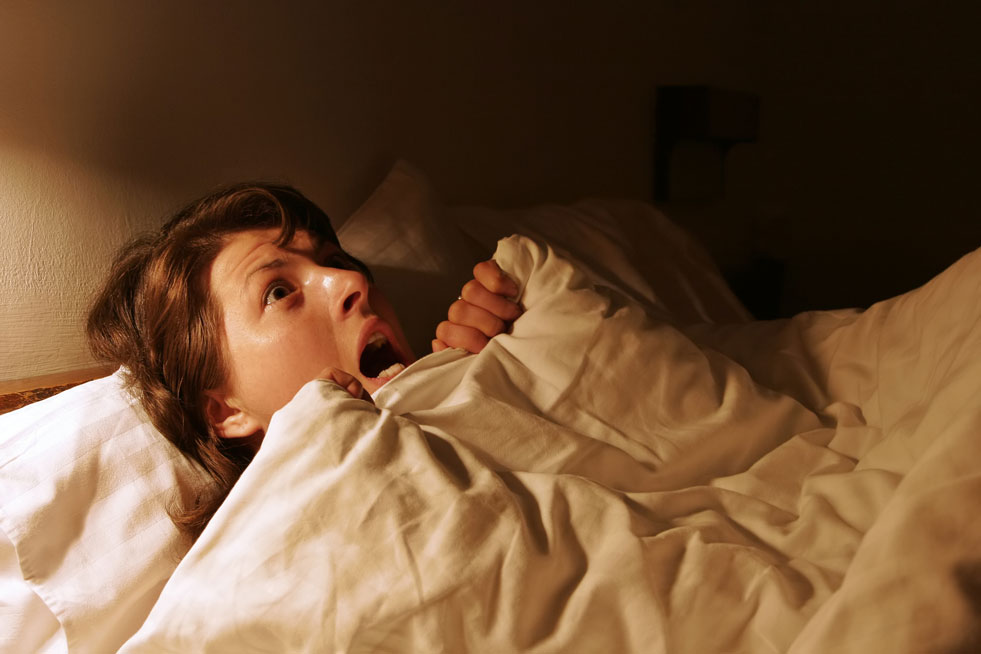
You’ve likely woken up from a nightmare with sweaty palms, a heart pounding out of your chest, and disturbingly vivid images that linger in your mind. Even though they’re not real, the intensity of nightmares can make them particularly disturbing. Unlike the typical bad dream, nightmares can jolt you out of sleep, with a strong emotional response, such as fear, sadness, or anxiety.
Frequent nightmares can be a scary experience and may leave you feeling emotionally drained and irritable. These are symptoms of a condition called nightmare disorder, which can occur on its own or alongside more serious issues like post-traumatic stress or anxiety disorders.
Scientists are exploring the concept of dream hacking — stimulating the sleeping brain to “engineer” sleep as a treatment method for nightmares and other conditions such as memory loss, strokes, and mental health issues. It sounds like something out of a sci-fi movie, but sleep specialists at the Geneva University Hospitals have been testing sleep engineering techniques that can help. (1)
Stimulating Sleep for Healing
Sleep engineering focuses on using the power of sleep to heal rather than just ensuring a good night’s rest. One of the techniques in this field is a take on imagery rehearsal therapy, which has the patient rehearse or re-script distressing dreams, but with a twist.
A trial tried new brain-stimulating techniques on 36 people with nightmare disorder (ND) who had had image rehearsal therapy. Half were exposed to “targeted memory reactivation” using a specific sound (TMR group), and the other half were not (control group). For two weeks at home, patients practiced IRT nightly and were exposed to the sound during REM sleep via a wireless headband detecting sleep stages.
After two weeks, the TMR group had fewer nightmares and more positive dream emotions compared to the control group, with effects lasting up to three months. Based on the study’s results, using targeted memory reactivation sounds during REM sleep might mean relief for people with ND. It could also help other psychiatric conditions by altering dream emotions.
Interestingly, the researchers also looked at how the stimulation during the first and last two nights impacted REM sleep. They found it didn’t have any effect, whether people in the group were getting the particular sound or not, and as time went on, their REM sleep stayed the same. This means that the sound, whether played or not, didn’t affect the pattern of their REM sleep — an essential factor since getting enough of this stage is vital for feeling refreshed and consolidating memories and could play a role in preventing dementia.
Study Findings Recap
- Imagery Rehearsal Therapy (IRT) helps lessen nightmares through cognitive strategies.
- Targeted Memory Reactivation (TMR) works to reinforce memories while you’re asleep.
- Combining IRT with TMR by replaying specific sounds during REM sleep enhances IRT’s benefits.
- This combination reduces nightmares and promotes more positive emotions in dreams.
The Future of Sleep Engineering
During sleep, your brain is not just idly passing time — it’s actively processing and consolidating memories, a process that can be enhanced through sleep manipulation. This has significant implications for conditions like memory loss and stroke, where the ability to form and retain new memories is often compromised.
Plus, sleep manipulation has the potential to improve emotional well-being. A good night’s sleep boosts mood and reduces anxiety, but these benefits can be taken up a notch with sleep engineering. It may be possible to enhance the brain’s natural processes for regulating emotions by manipulating sleep, which is a boon for mental health.
As the field of sleep engineering continues to evolve, potential risks and ethical concerns will inevitably come up. For now, the potential to improve nightmare disorder and mental health makes hacking sleep an exciting new field of research.
Memory Consolidation, Mood, and Mental Health
Memory consolidation is a crucial process that happens during sleep. It helps the brain convert daily experiences into long-term memories, which is essential for learning and memory retention. Two stages occur during this process–encoding memories into a temporary storage area in the hippocampus and then transferring them to the neocortex during deep sleep to be integrated with existing knowledge and stored as long-term memories.
This process has significant implications for mental health. According to Friederike Fabritius, neuroscientist, Wall Street Journal best-selling author, and sleep expert, “Memory consolidation during sleep is extremely important for mental health. When people experience lack of sleep or lack of quality sleep, they have trouble regulating their mood. Motivation goes down, as well as performance.”
Research suggests that enhancing memory consolidation during sleep can reduce nightmare frequency and improve mood (2). Nightmares are often brought on by unresolved emotional experiences or trauma, and by processing these experiences during sleep, there’s a healing potential.
What’s more, memory consolidation can help with mood regulation, according to Fabritius. “This is why I have been teaching executives about the importance of sufficient quality sleep for over 15 years. There is no shortcut — if you are sleep deprived, you are not the best version of yourself, and it will even shrink your brain,” she says
However, it’s best to be cautious with any new, relatively untested form of brain manipulation. While the potential benefits are exciting, further research is needed to fully understand the implications of this complex process.
Sleep-Engineering Devices
Sleep engineering is growing to include new gadgets for use at home, making its benefits available to more people and changing how we think about sleep and recovery. For instance, a phone app that works with Apple Watch sensors can track and improve sleep by offering tailored advice for better sleep quality and stronger memory. Another example is a glove-like sleep detector that checks your body’s signals while you sleep, working to improve your rest and recovery process.
However, Fabritius has a cautious perspective on the current state of sleep-engineering devices. She says that labs have access to powerful tools such as TMS (transcranial magnetic stimulation) or deep brain stimulation, and while many companies claim their devices improve sleep quality, only some have solid studies to support their claims. “We are not even able to track sleep in a reliable and valid manner outside the laboratory. In the lab, sleep is measured with electrodes on your scalp. It’s only logical that a sleep tracker won’t be able to deliver much while tracking your movement, breathing rate, or blood flow,” she explains. But that doesn’t keep companies from making bold claims. “I would not invest into an ‘at home’ enhancement tool just yet,” she says.
Potential Risks
Although sleep engineering is fascinating, being aware of potential risks and ethical considerations associated with manipulating memory and sleep is wise. The brain is a complex organ, and sleep is a vital process still not entirely understood — altering these functions can have unpredictable outcomes.
“Every time you activate a memory, you change it. In theory, these techniques could even be used for very dark purposes such as brain washing or mind control,” warns Fabritius. Plus, the ability to manipulate memories raises questions about consent, privacy, and the potential for misuse.
Fabritius says there’s a need for further research, “Scientists are using extracellular recordings, fMRI, EEG, and other tools to study our brain while we sleep — and yet more and more people are sleep-deprived. Despite growing knowledge, people are having a hard time actually getting more and better sleep.” Investing in research to understand the potential risks and ethical implications of sleep engineering has to be part of the conversation for responsibly harnessing the power of sleep for healing and recovery.
Sources
1. Schwartz, Sophie; Clerget, Alice; Perogamvros, Lampros; “Enhancing imagery rehearsal therapy for nightmares with targeted memory reactivation,” Current Biology; https://www.cell.com/current-biology/fulltext/S0960-9822(22)01477-4?_returnURL=https%3A%2F%2Flinkinghub.elsevier.com%2Fretrieve%2Fpii%2FS0960982222014774%3Fshowall%3Dtrue; October 27, 2022.
2. Hutchison, I.C., Pezzoli, S., Tsimpanouli, ME. et al. Targeted memory reactivation in REM but not SWS selectively reduces arousal responses. Commun Biol 4, 404 (2021). https://doi.org/10.1038/s42003-021-01854-3
Fabritius, Friederike. Author interview. March 2024.




























